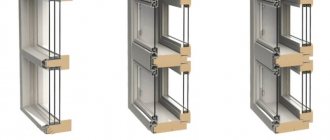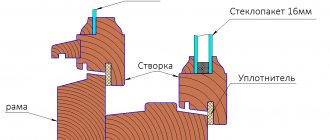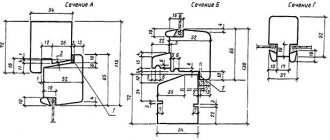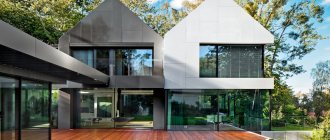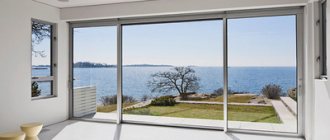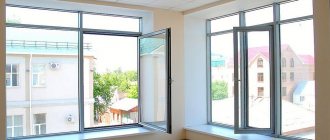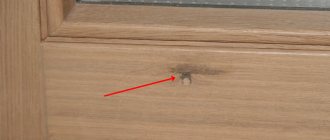In most Russian houses and apartments, white plastic frames with double-glazed windows have dominated for decades. Approaching the window, we turn the handle with the usual movement to tilt the frame and let a stream of fresh air into the room. Meanwhile, many remember that the homes of Soviet people had wooden double-layer windows, but few people know that the combination of the first and second options gives an impressive result.
Wooden windows Tiivi (Tiivi)
Tiivi has been producing its wood and wood-aluminum windows since 1977 and is the largest manufacturer in Finland. Every year, all of the company’s products are tested for heat and sound insulation properties, and it must be said – quite successfully. This is evidenced by the highest assessments of independent experts in Scandinavia and Europe. The sash and frame of Tiivi windows are made from high-quality northern pine and painted with Teknos water-soluble paints, which are durable and environmentally friendly.
Tiivi wooden windows are installed in most residential buildings, hotel complexes, museums and manufacturing plants located in any climate zone of the planet.
Finnish Tiivi windows are available in 4 types:
- Tiivi optimi
- Tiivi 1+2
- Tiivi 1+3
- Tiivi non-opening window
Manufacturers of Finnish windows and popular models
Finnish windows with frames made of wood or wood and aluminum are produced by several companies from Finland. The product line is popular not only in their country, but also in other countries with harsh winter climates. Noting the most popular of them, we will highlight the following companies:
- Tiiv.
- Profin.
- Fenestra.
- Skaala.
The peculiarity of these companies is that they have been engaged in production for a long time and have experience in this field. The end result is ideal Finnish windows, durable, reliable, warm and beautiful. Everything is done for the benefit of users.
Tiivi optimi
The cheapest window in the Tiivi model range is Tiivi optimi. Recently it has been available in the 2+2 version, i.e. There is a double-glazed window in the outer and inner sash. The low price for this window is due to the simplified aluminum profile and the fact that the calculations take into account the minimum number of sashes with opening for ventilation.
Among the technical characteristics of this window, we note the two-frame rotating design and the frame, which is made of laminated veneer lumber. Internal wooden frame + 4/16/4 double-glazed window with selective coating, argon filling, composite frame. Aluminum outer frame + 4 mm glass.
Rotary fittings “Abloy” made in Finland are installed on the window. The window has a heat transfer resistance coefficient U=1.0 m2C/W and belongs to energy saving class “A”. When using 4 mm thick glass, the sound insulation from road noise is Ra-33 dB. Box width – 130 mm.
1. General Provisions
1.1. This Personal Data Privacy Policy (hereinafter referred to as the Privacy Policy) is aimed at fulfilling the requirements of the Federal Law of the Russian Federation of July 27, 2006 No. 152-FZ “On Personal Data” and is valid for all information posted on the website on the Internet at https:/ /www.fenestra-ru.ru (hereinafter referred to as the Site).
1.2. The operator of personal data provided by the user when using the Site is OknaBau LLC. Legal address: 109451, Moscow, st. Bratislavskaya 18 to 1-422.
1.3. The User's use of the Site constitutes agreement with this Privacy Policy and the terms of processing of the User's personal data. In case of disagreement with the terms of the Privacy Policy, the User must stop using the Site.
1.4. This Privacy Policy applies only to the website https://www.fenestra-ru.ru. The Site does not control and is not responsible for third party sites that the User can access via links available on the Site.
2. Definition of terms
2.1. The following terms are used in this Privacy Policy:
2.1.1. “Site Administration (hereinafter referred to as the Administration)” - authorized employees who organize and (or) carry out the processing of personal data, and also determine the purposes of processing personal data, the composition of personal data to be processed, actions (operations) performed with personal data.
2.1.2. “User of the Site (hereinafter referred to as the User)” is a person who has access to the Site via the Internet and uses the services of the Site.
2.1.3. “Personal data” - any information relating to a directly or indirectly identified or identifiable individual (subject of personal data).
2.1.4. “Personal data processing” - any action (operation) or set of actions (operations) with personal data performed using automation tools or without their use, including collection, recording, systematization, accumulation, storage, clarification (updating, changing), extraction , use, transfer (distribution, provision, access), depersonalization, blocking, deletion, destruction of personal data.
2.1.5. “Confidentiality of personal data” is a requirement for the Operator or other person who has access to personal data to comply with the requirement not to allow their distribution without the consent of the subject of personal data or the presence of another legal basis.
3. Purposes of processing personal information of users
3.1. The site collects and stores only that personal information that is necessary to provide services, except in cases where the law provides for mandatory storage of personal information for a period specified by law.
3.2. The Site processes the User’s personal information for the following purposes:
3.2.1. Establishing feedback with the User, including sending notifications, requests regarding the use of the Site, provision of services, processing requests and applications from the User.
3.2.3. Confirmation of the accuracy and completeness of personal data provided by the User.
3.2.4. Providing the User with effective customer and technical support if problems arise related to the use of the Site and the services provided, work performed, and delivery of goods.
3.2.5. Conclusion of contracts, acceptance, processing and delivery of goods, provision of services and performance of work.
3.2.6. Carrying out advertising activities with the consent of the User.
4. Conditions for processing personal information
4.1. The processing of the User's personal data is carried out without a time limit, in any legal way, including in personal data information systems using automation tools or without the use of such tools. The processing of the User’s personal data is carried out in accordance with Federal Law dated July 27, 2006 N 152 - Federal Law “On Personal Data”.
4.2. The site has the right to send informational messages, including advertising messages, to the User’s email and mobile phone with his consent. The user has the right to refuse to receive advertising and other information without explaining the reasons for the refusal by informing the Site of his refusal by telephone or by sending a corresponding application to the email address.
4.3. With regard to the User's personal information, its confidentiality is maintained, except in cases where the User voluntarily provides information about himself for general access to an unlimited number of persons.
4.4. The site has the right to transfer the User’s personal information to third parties in the following cases:
4.4.1. The user agreed to such actions.
4.4.2. The transfer is necessary for the User to use a certain service or to fulfill a certain agreement or contract with the User.
4.4.3. The transfer is provided for by Russian or other applicable legislation within the framework of the procedure established by law.
4.5. In case of loss or disclosure of personal data, the Administration informs the User about the loss or disclosure of personal data.
4.6. The Administration takes the necessary organizational and technical measures to protect the User’s personal information from unauthorized or accidental access, destruction, modification, blocking, copying, distribution, as well as from other unlawful actions of third parties.
4.7. The Administration, together with the User, takes all necessary measures to prevent losses or other negative consequences caused by the loss or disclosure of the User’s personal data.
5. Obligations of the parties
5.1. The user is obliged:
5.1.1. Provide information about personal data necessary to use the Site.
5.1.2. Update, supplement the provided information about personal data if this information changes.
5.2. The administration is obliged:
5.2.1. Use the information received solely for the purposes specified in clause 3 of this Privacy Policy.
5.2.2. Ensure that confidential information is kept secret, not disclosed without the prior written permission of the User, and also not sell, exchange, publish, or disclose in other possible ways the transferred personal data of the User, with the exception of paragraphs. 4.4.1-4.4.3. of this Privacy Policy.
5.2.3. Take precautions to protect the confidentiality of the User's personal data in accordance with the procedure usually used to protect this type of information in existing business transactions.
5.2.4. Block personal data relating to the relevant User from the moment of application or request from the User or his legal representative or the authorized body for the protection of the rights of personal data subjects for the period of verification, in the event of detection of unreliable personal data or unlawful actions.
6. Dispute resolution
6.1. Before filing a claim in court regarding disputes arising from the relationship between the Site User and the Administration, it is mandatory to submit a claim (a written proposal for a voluntary settlement of the dispute).
6.2. The recipient of the claim, within 30 calendar days from the date of receipt of the claim, notifies the claimant in writing of the results of consideration of the claim.
6.3. If an agreement is not reached, the dispute will be referred to a judicial authority in accordance with the current legislation of the Russian Federation.
6.4. The current legislation of the Russian Federation applies to this Privacy Policy and the relationship between the User and the Administration.
7. Additional terms
7.1. The Administration has the right to make changes to this Privacy Policy without the User’s consent.
7.2. The new Privacy Policy comes into force from the moment it is posted on the Site, unless otherwise provided by the new edition of the Privacy Policy.
Tiivi 1+2
The Tiivi 1+2 model, unlike the Tiivi Optima, has a wider color palette and has additional equipment. In terms of technical characteristics, this window model is practically no different from the previous one. It also has a two-frame rotating design, an internal wooden frame with 4/16/4 glass with selective coating, argon filling and an aluminum frame that can be replaced with a composite one.
The window can be additionally equipped with a mosquito net, micro ventilation valve, inter-frame blinds and special glass. Box width – 130-205mm.
Additionally, the noise insulation of the Tiivi 1+2 window can be increased to Ra-38 dB.
Performance characteristics of Finnish windows
Finnish windows are considered the best based on heat and sound insulation. They have excellent performance characteristics. It’s not for nothing that structures are used in the harsh Scandinavian climate. They have the following advantages:
- The best thermal insulation performance.
- Excellent soundproofing properties.
- Resistant to precipitation and adverse weather conditions.
- Finnish designs are not afraid of temperature changes.
- There is natural ventilation in the room.
- Variety of products.
- Durability.
- Blinds can be installed in the inter-chamber space.
- The box is deep, ranging from 130 to 210 mm. The wall will not freeze, so there is no need to insulate the slopes.
As for the shortcomings, there are few of them. They involve regular processing of wooden products, since the varnish or paint on Finnish windows wears off over time. The second disadvantage is the high cost. But if you take into account the performance characteristics and advantages, then this is logical.
Finnish wooden windows with double glazing
The frame is made of laminated timber in three layers. Its thickness is 130–210 mm. The doors are made of two-layer laminated timber, the thickness of which is 46 mm. The moisture content of the wood used is 11–14%. The thickness of the outer glass can be from 4 to 6 mm.
Since wood needs protection, Finnish windows are treated with special compounds that extend the service life and improve the characteristics of the products. Water-acrylic based varnish or paints are used. Their advantage is resistance to atmospheric influences. They will not fade in the sun, are odorless and protected from moisture. The color palette is different.
Processing of Finnish wooden windows is carried out in the following stages:
- wood primer;
- surface grinding;
- applying a second layer of primer;
- re-grinding;
- 2 layers of painting - enamel and finishing with varnish.
Why is wood used for production? There are several reasons for this. The Finns chose wood for windows primarily because it is a natural and environmentally friendly material that is not harmful to health. In addition, Finland is a cold country, so the choice fell on natural material with minimal heat conductivity.
Other reasons:
- Wood allows the product to breathe. Thanks to this, the room always has fresh and clean air and an optimal microclimate. Ventilation is carried out naturally. There is no need to open the doors. Regular ventilation is very important for the room. But doing this in winter is problematic. Finnish windows do not need to be opened in the winter to provide ventilation.
- Condensation is a common phenomenon for plastic windows. But as for Finnish structures, condensation does not form on them. True, if the heating system is done correctly. There are several reasons why it can form: high humidity, lack of warm air circulation, installation of an incorrect double-glazed window, or improper installation of the structure.
- Using laminated veneer lumber from pine or larch, you get a durable product that, with proper care, will not collapse or deform during use.
- Wood retains heat better and gets colder less.
- Great appearance. Wood looks noble, beautiful and natural. In combination with the style of the house, a Finnish wooden window looks great.
The note! Finnish wooden windows are made from oak and larch. These are the most durable and durable options, but they have a high cost. Pine is a cheaper material, but has worse characteristics.
Finnish windows with two frames
Finnish double-frame windows can fit into any interior. But they are not only beautiful, but also very practical. Due to the two frames, a large air gap is formed, therefore the thermal insulation qualities of the structure are much higher, as is the sound insulation. A double-frame window is made of a wooden box, which is the basis of the product, as well as two separate frames. They can open inwards. The frame on the inside has a single- or double-glazed window, and the outside consists of glass or double-glazed glass.
Note! Thanks to the fittings, the two frames fit comfortably together. The two frames can open independently of each other, or like a regular window.
Finnish windows with two frames are practical and reliable. There are many factors that influence the value of heat transfer resistance. This includes the size of the product, the material from which the window block is made, the cross-section of the frame, the type of glazing, the number of seals, and their location. Designs with two frames are gaining more and more popularity, since despite their high cost, they have excellent performance characteristics.
Finnish plastic windows
Some plastic windows are called Finnish. But that's not true. Real Finnish windows, made using their technology, are made of wood, have two frames and a wide frame. One of the frames can be made of aluminum. But plastic is not used in this case.
But, in order to reduce the cost of construction, some manufacturers can make a window using Finnish technology, replacing one wooden frame with a metal-plastic one. You can meet such models. Their cost is cheaper, and ease of use is no different.
Tiivi 1+3
The Tiivi 1+3 plastic window has a similar two-frame, rotating design. But the glass unit here is different. A 4/14/4/14/4 glass unit with selective coating, filled with argon + an aluminum frame, which can be replaced with a composite frame, is installed in the internal wooden frame. The fittings here are also Finnish – “Abloy”. But the heat transfer resistance coefficient has become higher - U = 1.18 m2C/W.
The energy saving class is the same - “A”, but can be improved by using a different type of double-glazed window and changing the depth of the box. Sound insulation is Ra-35 dB, but can be increased to Ra-44 dB, so this window can be safely installed in a room overlooking a busy road or a noisy courtyard; you will not hear any noise and will enjoy the silence.
The width of the Tiivi 1+3 box is 170-205 mm.
"Continental" modification
Under the influence of German technology, Finnish companies began to produce tilt-and-turn windows. In essence, these are common German windows made from traditional Finnish materials and with the advantages of Scandinavian manufacturers.
What distinguishes them from conventional windows is:
- mandatory presence of aluminum flashing on the street frame;
- possibility of installing blinds.
To insert the blinds, the aluminum flashing is unfastened, and then slats are placed between the glass unit and the street frame.
Tiivi non-opening window
The Tiivi non-opening window has a single frame construction made of a wooden frame with 4/18/4/18/4 double glazing (selective coating, argon filled, composite frame). Box made of laminated veneer lumber. The window can be equipped with a micro ventilation valve, external blinds and special glass. Heat transfer resistance coefficient U=1 m2C/V. Box width 130-205 mm.
It is worth noting that, at the customer’s request, the external aluminum of the Tiivi window can be powder coated in any color according to the RAL map.
In addition, the Finnish window manufacturer offers three standard colors: white, gray and dark brown.
Installation of flashings and external slopes
The first thing we did was buy standard white shimmers, cut them to size and the ends were bent into a “wing” - I’ll explain why later
Low tide preparation
Then the window frame profile began to bother me. He's too cold. Therefore, after reading on the Internet, I decided to make a knight’s move and further insulate it.
A strip of ordinary polystyrene foam, which I obtained using a simple method, was ideal for this. A strip of approximately 1 cm thick is cut from a 5 cm sheet of foam plastic, then cut in half. We get 2 strips, 1 cm thick and 2.5 wide
This strip fits perfectly onto the stand profile, and is pressed underneath with foam from the mounting seam. I understand that the insulation is purely nominal, but still better than nothing.
Additional insulation of the support profile
After installing the foam, a thin groove remained at the bottom of the profile, into which the upper edge of the slope “jumped” perfectly and was pressed with the same foam. After the fact, professional window specialists also advised that this unit be sealed with silicone, but it was too late, and given my large overhangs, I get water at low tides once every century. The ebb itself was attached only with self-tapping screws to the edges of the window opening using the “wings”
Low tide installation
Then came the turn of the external slopes.
Here an unpleasant nuance emerged that I had not foreseen. When I tried to position the windows so that they stood in 1/3 of the insulated wall contour, I forgot about the distances from the edge of the profile to the plane of the facade.
In the end it turned out to be 90mm. And the board for the slopes was 100mm. I had to cut it. If I had moved the window 1 cm deeper, I wouldn’t have had to cut it, which would have saved time.
Again, for reasons of better thermal insulation, the slope was shifted to the profile, and the space between the slope and the opening was carefully foamed.
I was heavily criticized by window workers about this. Because the good news is that the foam on the outside needs to be waterproofed. But again - since in my case, water getting into these places is extremely unlikely, I decided to give a damn about it
Now an important Finnish moment. How the Scandinavians solve the issue of ebb and flow. First photo:
The slope is cut approximately 1 cm higher than the ebb
What is the essence of such a decision? If a lot of water flows at low tide, the end of the slope does not get wet. Accordingly, the tree will live longer.
And the “wing” of the low tide is hidden behind the slope - there is no need to additionally coat it with all sorts of silicones so that water does not get under the low tide.
Ultimately, this node looks like this:
Low tide in “Finnish style”
Finnish Lammin windows
The Finnish company Lammin IKKUNAT uses only selected knot-free coniferous wood in the production of its wooden windows. The windows of this company are made to order, taking into account the wishes of the customer. The client determines everything: from the size and model of wooden windows, frames and types of processing, to fittings and equipment.
Finnish Lammin windows have a rigid frame and strong frames. The outer frame of wooden windows is glazed on the inside, which increases durability. External wooden parts are made of wood impregnated under pressure with an antiseptic. The horizontal impost and the lower part of the frame are protected by an aluminum profile. Elegant bevels on the inner binding make cleaning easy.
Glazing can be two-chamber, three-chamber or four-chamber. At the customer's request, special selective glass can be installed.
The surface of the window can be processed to the customer's taste. Usually it's just painting. But Lammin also carries out protective impregnation, which does not change the color of the wood, and glaze. The standard colors for Lammin windows are brown, black and oak shades. Finnish wooden windows Lammin IKKUNAT are supplied with installed seals, sealing gaskets and fittings, including vent clamps.
Window sill installation
The length of the window sills should be 100-200 mm longer than the window opening. The protruding part is on average 70 mm.
Window sill installation:
- Cut out the required size from the prepared material.
- The outside is lined with felt.
- Place the window sill blank under the frame.
- Level the window sill using wedges. The permissible slope is up to 2 degrees.
- The voids must be filled with foam. A pistol is used for this.
Double glazed Lammin windows
The difference between these windows and conventional double-frame windows is that both frames can open simultaneously. For this, a special mount is installed (see photo). At the request of the customer, a double-glazed window installed in an internal wooden frame can have different formulas. Wind protection glass is installed in the outer (outdoor) frame. This frame is made entirely of aluminum to prevent the influence of the external environment, the window frame is closed with an aluminum cover. These windows are the best solution for glazing country houses and city apartments.
Two frames and a deep frame eliminate the formation of moisture in the room, and the double-glazed window remains dry in any frost. Double-frame Lammi windows, even with standard double-glazed windows, have a heat loss coefficient much lower than single-frame ones, which allows you to save money on heating the room.
If you are tired of noise from the street, then Lammi windows are your choice. The use of special glass can significantly improve the sound insulation of windows and significantly reduce acoustic discomfort in the room caused by the noise of city streets. Such windows are the best option for installation in an apartment.
Design
The main feature that distinguishes Finnish products from all other designs of window units is the presence of two frames, one glass is inserted on the outside, and a double-glazed window on the inside (in more expensive options, double-glazed windows are in both frames). A special device connects both frames, so that they can only be opened together and only in a horizontal plane.
It would seem that this opening option could impede ventilation, but practical Finns took care of this by equipping their windows with a special device. Ventilation is carried out using a supply valve mounted on the top of the movable frame. Its design assumes the presence of filters that trap dust, poplar fluff, and pollen of flowering plants. They purify the air entering the room from allergens.
In addition, the valve creates a barrier to noise and prevents the windows from fogging. It can be in three positions:
- closed;
- half-open (winter ventilation);
- open (summer ventilation).
Valveless windows have a classic design with a window (transom).
Finnish wooden windows Fenestra
Fenestra is another large manufacturer of timber and timber-aluminum windows in Finland. Every year the company produces over 310 thousand windows and balcony doors according to customer sizes and configurations.
The model range of Fenestra windows is presented in three modifications:
- openable windows;
- non-opening windows;
- special windows.
Fenestra windows from the range of standard models are perfect for those looking for a reliable and classic solution. The right choice of windows will have a positive impact on living comfort for decades, without compromising on energy efficiency.
Fenestra Primus
Fenestra Polaris is an energy-saving window with a heat transfer coefficient of 0.80. Fenestra Polaris windows fully comply with the highest requirements for thermal insulation of opening windows. Unlike traditional double-hung MSE windows, the outer aluminum sash of the Polaris window is equipped with single-pane glass. This design provides increased thermal insulation properties of the window and its suitability for use in energy-efficient and passive houses.
Fenestra Primus is a cost-effective, energy-saving class “A” window with a heat transfer coefficient of 1.0. Fenestra Primus is the most cost-effective solution when a client is looking for a traditional and energy-efficient MSE window design. The Primus window belongs to class A for energy efficiency and complies with the thermal insulation requirements coming into force in 2012. The carefully crafted interior sash, with its 45-degree bevel cut, beautifully frames the view from the window.
Fenestra Basic is a pearl among wooden windows. Fenestra Basic windows can be called a real gem of carpentry. The inward opening wooden windows are of double-hung MSE type construction with three layers of glazing. Basic windows are best suited for installation in older buildings and allow you to maintain the look and feel of old wooden windows.
Fenestra Fixed is a non-opening window with energy efficiency class “A+”. The Fenestra Fixed non-opening window allows you to create large window surfaces. Due to the excellent thermal insulation properties of these windows, floor surfaces that are close to the glazed surface can be used more efficiently.
Fenestra Fenix – comfort as standard. A window with a beveled profile is designed specifically for private homes. The Fenix window, with its striking design, successfully combines Central European style with Finnish insulation requirements. The single-hung window is an exciting new addition to Finnish window culture. Tests have confirmed that the heat transfer coefficient of Fenix windows is 0.89 W/m2K, which allows this model to successfully compete with other windows in the company's range.
Advantages and disadvantages
Undoubtedly, Scandinavian windows have a number of advantages compared to plastic windows of traditional German design, and even more so with Soviet-style wooden windows. They are characterized by:
- high noise insulation due to double glazing and double glazed windows;
- no condensation or fogging;
- environmental friendliness and aesthetics of wooden products;
- durability (from 50 to 100 years), guaranteed by the use of modern wood processing methods;
- increased thermal insulation, which is provided by a thermal curtain - an air gap between the frames that prevents the passage of cold air;
- reliability due to many years of production experience.
The flaws (or rather, the features) can be attributed to some negligence in external details: minor defects on the wood are possible. Finnish manufacturers do not pursue external effects, focusing on naturalness - in a traditional Russian and European window this is, as a rule, unacceptable. Another significant drawback is the relatively high cost of Finnish window products.
Special models
Special models are a good solution when the customer seeks to maximize the use of all window capabilities. Improved energy efficiency, sun protection or fire protection ensure that products best meet customer needs. Fenestra is constantly working on product development to fully meet customer needs and modern housing requirements.
Fenestra Fenair
Fenestra Fenair with a supply air valve for windows in renovation projects.
The Fenair fresh air valve is a simple and inexpensive solution that allows you to equip Primus or Polaris windows with a fresh air ventilation device. The heat transfer coefficient U, determined in laboratory tests, is 0.86. When passing between the doors, cold air heats up by even 20 degrees. The upgraded filtration unit provides an optimal thermal cycle and a large filter surface. The Fenair supply air valve is equipped with an air outflow limiter and a manual air flow regulator.
Additional equipment for Finnish windows
The main advantages of Finnish windows include the fact that they can be supplemented with various functional equipment that improves their performance and simplifies maintenance.
The main element in the system are blinds. They allow you not to use curtains or curtains for windows, thereby not hiding the beauty of the Finnish window. In this design, the blinds are installed in a special way. Since a large space is formed inside the frame between the shutters, it becomes possible to install special blinds there. It is noteworthy that to adjust the blinds inside between the frames, it is not necessary to open the shutters. The mechanism is well thought out, because all manipulations (raise, lower, curtain) are done using a handle or control system on the frame indoors. In the photo below you can see the design of such blinds. They are made specifically for Finnish windows; ordinary ones will not fit.
Blinds are installed using brackets that are fixed to the top of the outer frame. The rope is passed into the rod through an adapter. The rod passes through the interframe space and is guided into the room. Clamps are made on the frame to hold the blinds in the selected position.
What are the advantages of such a solution? The structure is reliably protected inside the frame from external influences. Dust, dirt and moisture will not get on it. And the likelihood of mechanical damage is reduced to zero. The selection and ordering of blinds is carried out at the stage of purchasing a Finnish window.
To ensure natural ventilation in the closed position of the valves, a supply valve is used. It is installed in the window frame or sealing gap. The valve can be manual or automatic. In the first case, you will have to adjust the fresh air supply yourself. However, the cost of the valve is cheaper. The automatic valve has a sensor that can detect the humidity in the room. It regulates the amount of air in the room itself. The principle of operation of the valve is visible in this photo:
Finnish wooden windows Profin (Profin)
Fixed window PROFIN
The Profin company has been manufacturing windows, regular and sliding doors for over 35 years. The quality of the products meets the requirements for construction products in harsh northern conditions.
All company products are divided into four series: North, Active, Clear and Core.
DK North series windows are popular due to their safety and convenience. One handle serves both to close the window and to tilt it inward for ventilation or to swing the sash inward.
In the ventilation position, the window is tilted inward at the top and a gap is formed, which ensures quiet and pleasant ventilation. You don't have to remove things placed by the window to ventilate the room. In the ventilation position, the window structure drains rainwater outside.
For washing, the window opens towards the inside. Since the window structure consists of one frame, only two glass surfaces need to be washed. When closing, the window is pressed hermetically due to the multi-point lock.
DK windows are completely safe, since in the ventilation position they open inward only at the top. The window can easily be used as an emergency exit: to open the sashes you only need one turn of the handle, while fittings for the ventilation position or other locking mechanisms do not interfere with the quick opening of the window.
DK windows can be used as doors to French balconies or other similar entrance structures. The single-frame window opens like a door and can also be moved into position for ventilation. A “door” slightly open for ventilation does not create a danger for the smallest family members and will not allow your pet to escape.
Useful tips
Expert advice may be useful to you:
- If the window frame is planned for painting, the surface for painting is primed. This will extend the life of the frame and save paint. Paint in several layers.
- For high precision work on frame manufacturing, a high-quality tool is important - a machine for guaranteed dimensional stability.
The most dangerous stage of the work is glazing. Follow safety precautions:
- Wear gloves.
- Wear safety glasses.
- Do not breathe through your mouth or talk to avoid inhaling glass chips.
North series fixed windows
A fixed window can be attached to a panoramic sliding door. This allows you to create window surfaces that are uniform in design and style.
The window can be equipped with horizontal or vertical dividers. Decorative boring can be made along the edges of the frame. The frame can be equipped with a partially covering structure, which serves both as an element complementing the style and as a means of protecting glass in rooms with increased user activity.
Using a fixed window
According to their technical characteristics, fixed windows are best suited for buildings with increased requirements for thermal insulation and mechanical ventilation. Profin windows are made from selected dense fiber raw materials, the production and use method of which provides the windows with a long service life. The glass unit used in fixed windows is carefully fitted to the frame structure and tightly insulated. The window design and its technical solutions reflect our long experience as a window manufacturer: every detail is designed to be durable.
For properties that require an opening model, we can recommend the window we manufacture with the DK design. This window is reliable, easy to care for and manufactured to the same high quality standards as all our other products.
Types of frames with double-glazed windows
This Finnish model is made of wood.
It was the wooden structure that became the basis for various modern modifications. The wood that is traditionally used for the production of Finnish window frames is oak, larch and pine. But there are samples made of ash and mahogany.
To extend the service life and preserve the aesthetic appearance of the window frame, water-based paint and premium varnish are used.
only wood is used to make windows . This material “breathes”, is environmentally friendly and retains heat perfectly. Indoors, wooden windows maintain a comfortable microclimate; condensation does not form on the windows.
In addition to wooden window frames, combined and plastic models began to be produced using Finnish methods. Combined models are coated with aluminum on the outside to make the outside of the window frame more resistant to external weather conditions, while maintaining the appearance and attractiveness of the original model.
This combination involves the use of two materials in manufacturing - wood and aluminum.
Combined samples can be made in 3 options:
- Only the outer doors are made of aluminum, while the frame and the rest are made of wood.
- Only the frame is made of aluminum profile, and both doors are made of wood. The outer side has metal lining.
- The frame and both doors are closed from the outside with an aluminum profile
The metal profile is firmly fixed to the wood base and forms a single whole with it, thanks to the fact that the manufacturer uses special locking connections for fastening wood and aluminum profiles.
Plastic structures made using Finnish technology are produced in 2 types:
- one common frame and 2 doors;
- design of 2 frames, which are fastened to one another with a special profile.
The opening method for Finnish windows is the same - 2 hinged sashes, which have the following features :
- the internal doors are equipped with double-glazed windows, which increases heat and sound insulation compared to double-leaf structures with one glass;
- external and internal sashes are interconnected, which simplifies the operations of opening and closing the window, since both rows of sashes can be opened simultaneously;
- for ventilation, the structure can be equipped with a window or transom.
Active series fixed windows
The window in this collection does not have a separate frame. It can be attached to the surrounding structures in such a way that the unity of the line of the internal and external surfaces will be interrupted only by glass. The deep frame allows for the use of various glazing options.
Thanks to its tightness and soundproofness, the structure is able to meet even the most stringent environmental requirements. The solid wood structure effectively insulates heat. Northern dense-grain pine, larch or oak can be used as raw materials.
Areas of application of the Finnish glazing system, Lumon system
Frameless structures are designed for decorating gazebos, loggias in apartment buildings, terraces and verandas in private cottages. Popular systems are for open and semi-enclosed public spaces (exhibition halls, lobbies, business centers, office premises, winter gardens). Aesthetic designs are used as interior structures for restaurants and cafes.
In Finland, frameless glazing systems are common in the architectural design of multi-storey residential buildings. Lumon complexes are adapted to the climatic characteristics of regions with cold winters. The systems are frost-resistant and suitable for temperature conditions of -55…+70°C.
Finnish wooden windows Skaala
Skaala was founded in 1956 and is a supplier of goods and services to one of the largest Nordic companies specializing in the manufacture of windows, doors and various glazing options.
Skaala is a Finnish family business where strong carpentry tradition, experience and know-how are combined with modern production methods and innovative technological solutions. Skaala is renowned for its energy-efficient products and comprehensive service concept. In addition to the fact that Skaala has a significant share in the domestic market, the company's products are exported. mainly to Sweden, Great Britain and Russia. Skaala exports through its dealers operating in these countries.
Canopies over trims
Many Finnish projects have a canopy over the top trim. I liked this option, but was too lazy to do it.
But two things played a role here. Firstly, I made a mistake with the amount of boards and I had several painted planed boards left that needed to be attached somewhere.
Secondly, I came across a short report on the forum house about how a friend made himself such visors and wrote that the house began to look much better.
I decided to conduct an experiment and make one visor for testing.
The canopy must be a window, to be or not to be
After which, at the family council, it was decided to have visors.
By and large, both options look good. But visually there is a moment. The visor complements the “rustic style” very well and is combined with the glazing. But if the house is in a more modern style, without glazing, then the canopies would be superfluous.
Important Note
To make the canopies look good, they need to be tilted exactly the same as the slope of the roof! In my case it is 23 gr.
In modeling the canopies, I went further than my colleague from FH, in the sense that for a more beautiful result, the part of the canopy that is adjacent to the wall and the upper part of the casing should be filed at an angle.
But I started with decorative consoles. Since I didn’t have a router and had a limited amount of material, I decided not to be aesthetic with complex shapes, and to make consoles that were simple in shape but optimal in cutting. The consoles themselves were cut out with a jigsaw
Cutting - from one section of the board we get 2 consoles
After cutting, paint on all sides
Then it was time to file the top casing and the visor at an angle.
For this purpose, a small device was made
The essence of the device is quite simple. The part is fixed, and a stop board is fixed on top, at the required distance from the edge of the circular saw to the saw blade. And then saws, pressing the circular saw against the stop
It doesn't turn out perfect, but it's neat enough.
I decided to attach the consoles to the platbands with finishing nails, according to the following scheme
Since the consoles serve more of a decorative function, very powerful fasteners are not required there.
Well, here it is - the result
But this was not the end.
Skaala Alfa
Alfa windows allow you to achieve thermal insulation and energy saving indicators that are the most effective on the market. A new glass unit design, effective solar protection, and a Thermo-sash ensure the energy-efficient and heat-resistant Alfa design in all conditions. The excellent sound insulation value of this design with 2+2 glazing also creates even greater comfort, especially in buildings located in densely populated areas with heavy traffic. In addition, it should be noted that the problem of freezing of energy-saving windows does not affect Skaala Alfa windows, since Skaala Alfa windows are equipped with a special FrostFree coating on the glass, which protects them from freezing.
What we offer with plastic windows
Our company offers to order plastic windows taking into account different glazing options. We try to make our products as affordable as possible, therefore we produce PVC windows for Muscovites in a different budget range: from economy class to luxury designs with energy-saving functions, tinting, and the like.
The sale of metal-plastic windows is complemented by a set of related services. Our specialists - builders-installers - carry out a wide range of work, which includes the installation of slopes, ebbs, window sills, as well as other elements. We not only sell windows, we are able to create glazing for any objects.
PVC profiles
PLASTIC PROFILE SYSTEMS
KBE
EXPROF
REHAU
PLASWIN
Skaala Beeta
If you prefer traditional, high-quality 2+1 glazed windows that meet future energy efficiency requirements, then Skaala Beeta windows are your choice. In addition to the wood-aluminium construction, Skaala Beeta windows can also be ordered entirely in wood. All Skaala Beeta windows can be either opening or fixed. The Skaala Beeta N_08 window is equipped with glass with a special FrostFree coating, which protects them from freezing. At the customer's request, this option is also available in other Beeta window models.

